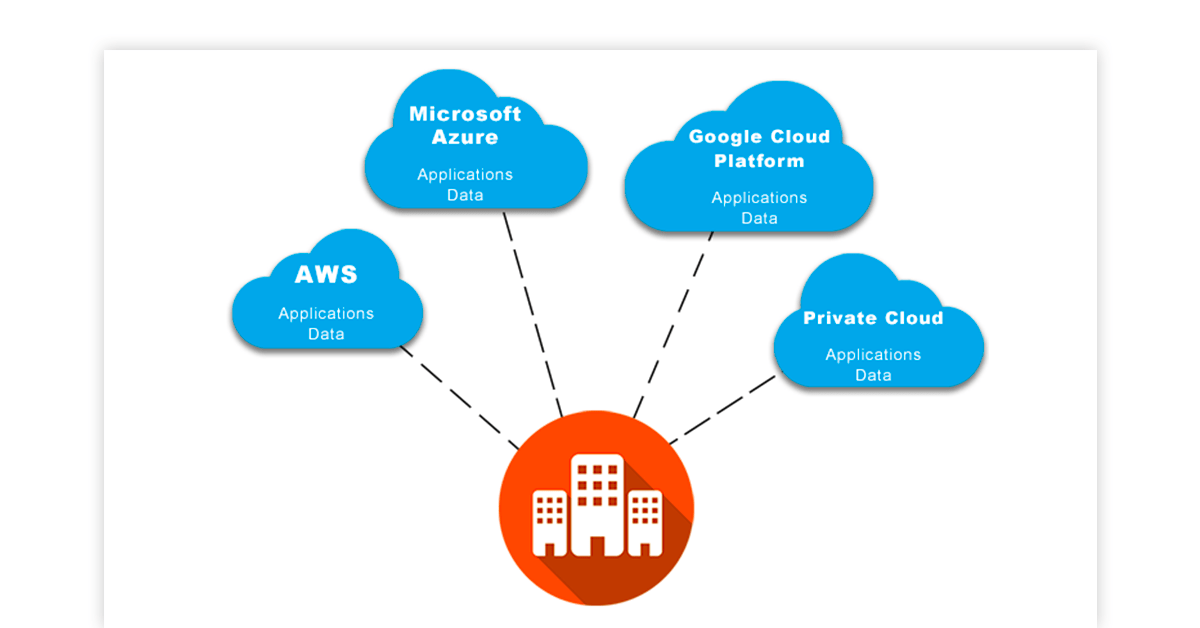Multi-cloud Ecosystem- A New Cloud Adaption Model for Greater Agility

Multi-cloud is the use of multiple cloud computing and storage services within a single network architecture. In other words, the process stands for distribution of cloud assets, software, applications, and more across several cloud environments. Multi-cloud architecture deploys a multi-cloud environment. In a multi-cloud environment, you would thus find support for two or more public clouds as well as private clouds.
Multi-clouds are especially designed for eliminating reliance on any single cloud provider or instance. As per Gartner and Forrester survey, around ninety-three percent respondents informed that they were using ‘multiple infrastructure clouds’ for most of their business operations.
The report further highlighted how around eighty percent of enterprises depend on multiple public clouds and one or more private or dedicated clouds.
Multi-cloud diagram showing an enterprise using multiple cloud service providers for data storage and application delivery.
What is Multi-Cloud?
Multi-cloud is the use of two or more cloud computing services from any number of available cloud vendors. A multi-cloud environment could be all-private, all-public or a combination of both. Companies use multi-cloud environments to distribute computing resources as well as minimize the risk of downtime and data loss. This is also critical for increasing the computing power and storage available to a business.

Innovations in the cloud in recent years have resulted in a move away from single-user private clouds to multi-tenant public clouds and hybrid clouds. The latter provides a more heterogeneous environment for leveraging different infrastructure environments like the private and public cloud.
Why Use a Multi-Cloud Strategy?
A multicloud ecosystem/ strategy allows companies to select different cloud services from different providers because some are better for certain tasks than others. For example, some cloud platforms specialize in large data transfers or have integrated machine learning capabilities. Organizations implement a multi-cloud environment for the following reasons:
- Choice: The additional choice of multiple cloud environments gives an end user the flexibility and ability to avoid vendor lock-in.
- Disaster Avoidance: Outages happen; sometimes it is due to a disaster; other times it is human error. Having multiple cloud environments ensures that you always have computing resources and data storage available so that you can avoid downtime.
- Compliance: Many multi-cloud environments help enterprises achieve goals for better governance, risk management and handling compliance regulations.
- Reduced Cloud Spending: Adopting a multi-cloud strategy along with an on-premise storage setup is one of the best ways to avoid mounting cloud bills. Overspending on the public cloud like AWS, Microsoft Azure, and Google Cloud can be reduced if you move some of your data on-premise. NetApp hybrid cloud setup with on-premise and public cloud combination will optimize your IT infrastructure and lower the overall spend.
What is Multi-Cloud Management?
Multi-cloud management involves workload or application performance management as information moves from one cloud platform to another. This requires an organization to have expertise in the field of cloud management as well as good information regarding multiple cloud providers.
How Secure is Multi-Cloud?
Multi-cloud security has the specific challenge of protecting data distributed across a variety of cloud providers. When a company uses a multi-cloud approach, third-party partners handle different aspects of security. That is why it is important in cloud deployment to clearly define and distribute security responsibilities amongst the parties.
What are the Benefits of Multi-Cloud?
A multi-cloud platform combines the best services offered by every single cloud provider. This allows companies to customize an infrastructure as per their targeted business goals. There is also less risk involved in multi-cloud architecture because if one web service host fails, a business can still run using other available platforms of a multi-cloud environment.
A multi cloud system enables you to pace up the daily operational tasks. Cloud service providers such as NetApp help in building a modern hybrid cloud infrastructure that provides the flexibility to store your data on both, cloud and on premise. This will help your business adapt to changes quickly, easily and enable you to gain competitive advantage.
Multi cloud computing with on premise data storage can also help you save data storing costs. For example, in 2018, a NetApp customer had leveraged its Snapshots service to minimize its disaster recovery cost. With NetApp’s Snapshots, the customer managed to bring down its spending on AWS by 50%.
Suggested Read: List of Best Free Cloud Storage Services in 2022
What are Examples of Cloud Providers?
There are many public cloud providers including:
- AWS
- Google Cloud Platform
- IBM Cloud
- Microsoft Azure
- Openstack (private cloud)
- Oracle
- VMware Cloud
The Techjockey content team is a passionate group of writers and editors dedicated to helping businesses make informed software buying decisions. We have a deep understanding of the Indian software market and the challenges that businesses face when choosing the right software for their needs. We are committed... Read more
















